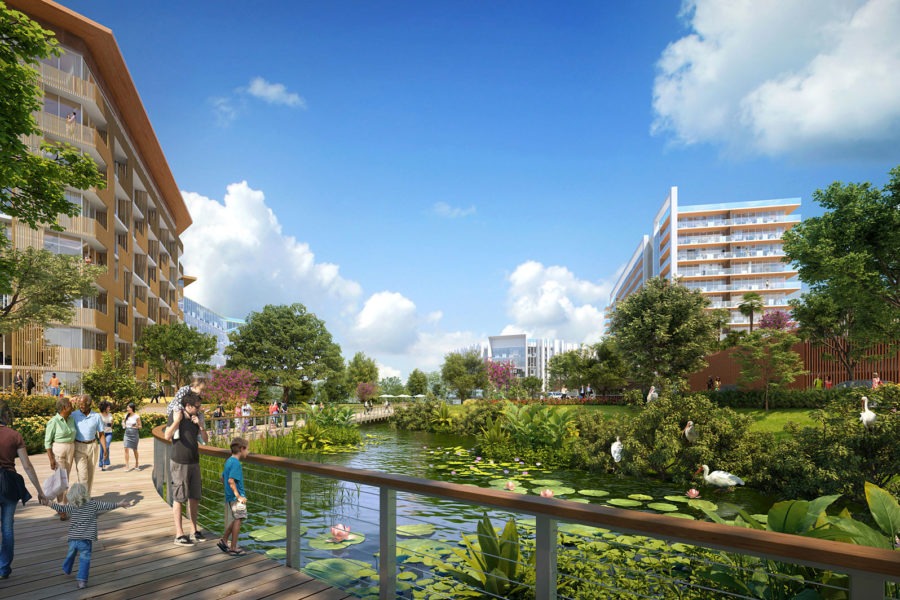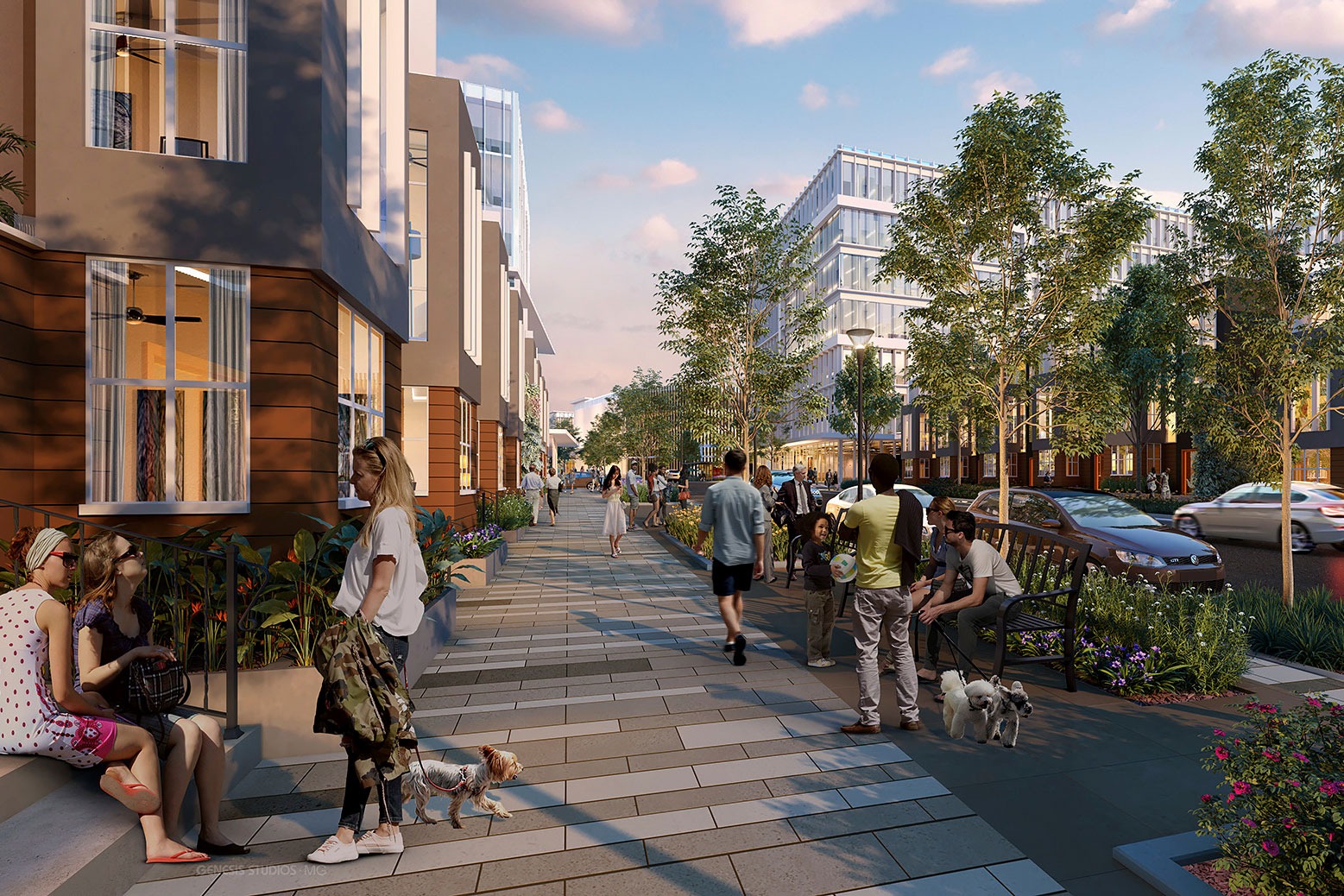Story at a glance:
- Tactical urbanism refers to a type of urban planning that is shifting away from car-centrism into making cities greener, safer, less polluting, and more equitable.
- In this shift to sustainability, tactical urbanism emerges to redesign public places to be people-centered by creating, for example, pedestrian plazas.
- Examples of tactical urbanism exist worldwide in both large and small cities, heralding the transition to healthier car-free zones.
What do traffic cones, raised lane separators, and plant-filled wooden crates have in common? They make up the arsenal of tactical urbanists used to create bike lanes, pedestrian plazas, mini-parks, or pop-up dining where there once were cars or lines of traffic in cities.
What is Tactical Urbanism?

The street framework of Broward County Arena Concept Master Plan has been organized to balance pedestrian, bicycle, and automobile traffic. All streets have been designed to accommodate wide sidewalks buffered from automobiles with street trees and planting areas and include a range of shading devices such as arcades, awnings, and overhangs to enhance pedestrian comfort. Rendering courtesy of Arcadis
Coined by New York urban planner Mike Lydon and described in his 2015 book coauthored with planner Anthony Garcia, Tactical Urbanism: Short-Term Actions for Long-Term Change, tactical urbanism refers to a sustainable urban development movement spearheaded by concerned citizens, community groups, area businesses, or local governments who are working to create an urban infrastructure, one small project at a time. These efforts aim to get people to come together in places previously dominated by parked or moving vehicles.
Besides making cities more people-friendly, tactical urbanists aim to design safer places for pedestrians, children, runners, and cyclists. Often disgruntled residents, frustrated by non-action of their municipalities, take initiative by painting crosswalks at dangerous intersections or installing signage in accident-prone areas.
Creating ghost bike memorials—complete with a white-painted bike surrounded by flower bouquets—at the scene where a cyclist died is a gripping display by tactical urbanists driving home their point of a vital need for safe cities.
In its most common form, tactical urbanism promotes public and participatory activities, temporary in nature, where people repurpose curbside parking spaces into mini-parks, walking or biking lanes, and social hubs. In the process these individuals are advocating for safer, greener, and more equitable streets for local communities to congregate among more walkable communities.
“Simple greening and gardening solutions aside, the reality is that many people who live in cities are without their own private outdoor space; cities must better plan urban neighborhoods to offset this with their proximity to open green spaces,” Renee Schoonbeek, senior consultant stations and urban development at Arcadis, previously wrote for gb&d.
Advantages of Tactical Urbanism
There are numerous advantages of tactical urbanism. The major ones include:
Democratic. Multiple stakeholders, including residents, city planners, and business groups, work together to make projects happen.
Economical. In most cases individuals involved in tactical urbanism activities already own the materials (outdoor furniture, artificial turf, etc.) and contribute them for shared use.
Enjoyable. Humans are naturally sociable and love being in community with friends and neighbors.
Healthy. Poor air quality from auto emissions is a leading cause of premature death and cardiovascular diseases worldwide. Since tactical urbanism reduces or temporarily eliminates vehicular traffic, pedestrians benefit from cleaner air.
Disadvantages of Tactical Urbanism
Tactical urbanism has a couple of disadvantages such as:
Resistance from drivers. Some people who work in the city may not like public transportation or have access to it from their home.
Dislike by traditional city planners. City employees used to overseeing multi-million dollar road and bridge projects may find small, temporary tactical urbanism initiatives bothersome or irrelevant.
Non-suitability in densely populated cities. Some cities, like New Delhi or Mexico City, are so crowded that it may be difficult to carve out space for tactical urbanism projects.
Examples of Tactical Urbanism
Global examples of tactical urbanism abound. In 2020, as the world locked down due to Covid, efforts to make cities more amenable to outdoor activities escalated, often driven by local governments in the name of public health. Overwhelming positive responses from citizens have resulted in making many of these changes permanent aspects of city life.
Let’s look at a few places where tactical urbanism rules the day.
Seattle
When restaurants, bars, and other small businesses shut down as Covid hit the Pacific Northwest in 2020, the idea of building pergolas on the sidewalk and into the street on Ballard Avenue served as the lifeline for everyone. Neighbors flocked in support to patronize them and the weekly farmer’s market. The Seattle Department of Transportation (SDOT) complained about lost revenue from street parking, and the historic district board opposed the makeshift construction. With the help of a supportive city council member, the businesses got a renewed lease on life when an ordinance passed to keep the pergola idea—but mandated a facelift to make the structures fit into the historic nature of the district.
San Francisco
The original Park(ing) installation occurred in San Francisco in 2005. The brainchild of three designers interested in open source urban design that recaptured public spaces from cars and gave them back to the people for art, culture, and play, Park(ing) Day is now an annual event in hundreds of locations around the world. The next one is slated for September 20, 2024. While each one has a unique personality, they often include outdoor furniture, artificial turf, and planters. Once then-SF mayor Gavin Newsom witnessed the power of community of what he dubbed parklets, he initiated Groundplay to extend the project throughout the city.
Berlin
Although public transport is a key feature of a sustainable city, throw a highly contagious virus in the mix and everything changes. A quick-thinking city employee set out to make bicycling the go-to mode to get to school or work. More than 16 miles of pop-up bike lanes were born and instantly became a success. The German Cyclists Association estimated city riding increased by 25%. Their popularity led to the city deciding to make them permanent.
Urban sustainability activists have not stopped there. Car-Free Berlin is a group advocating for a government-approved ban on all vehicular traffic in the city’s center. Through this initiative Berlin follows Paris and Barcelona, other European cities which have already closed off 100+ streets to vehicular traffic to reclaim safe, air pollution-free space for pedestrians.




